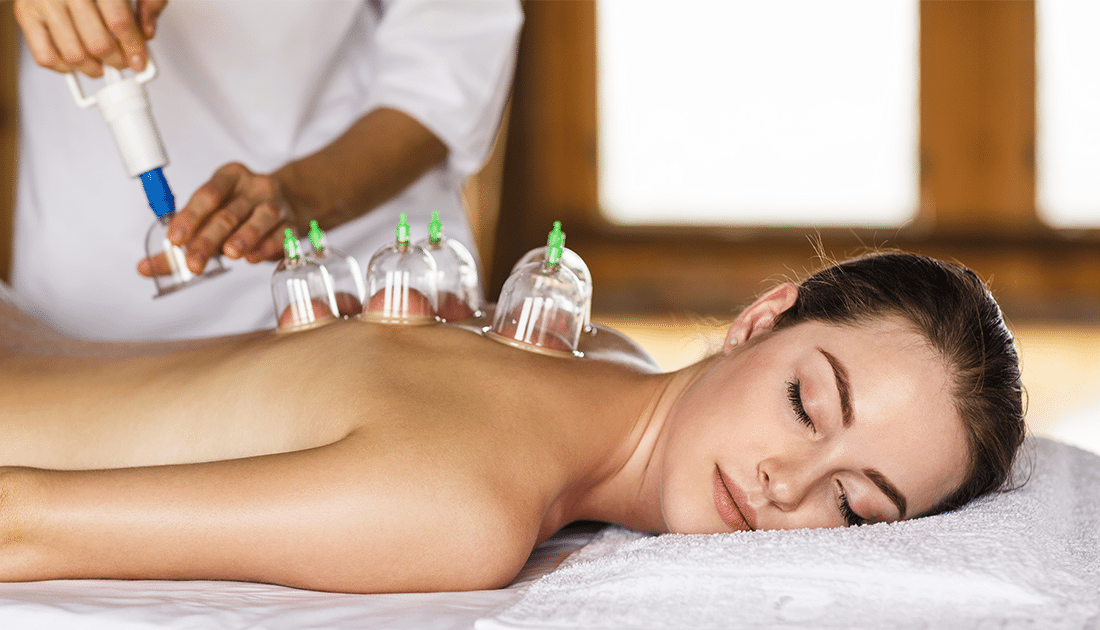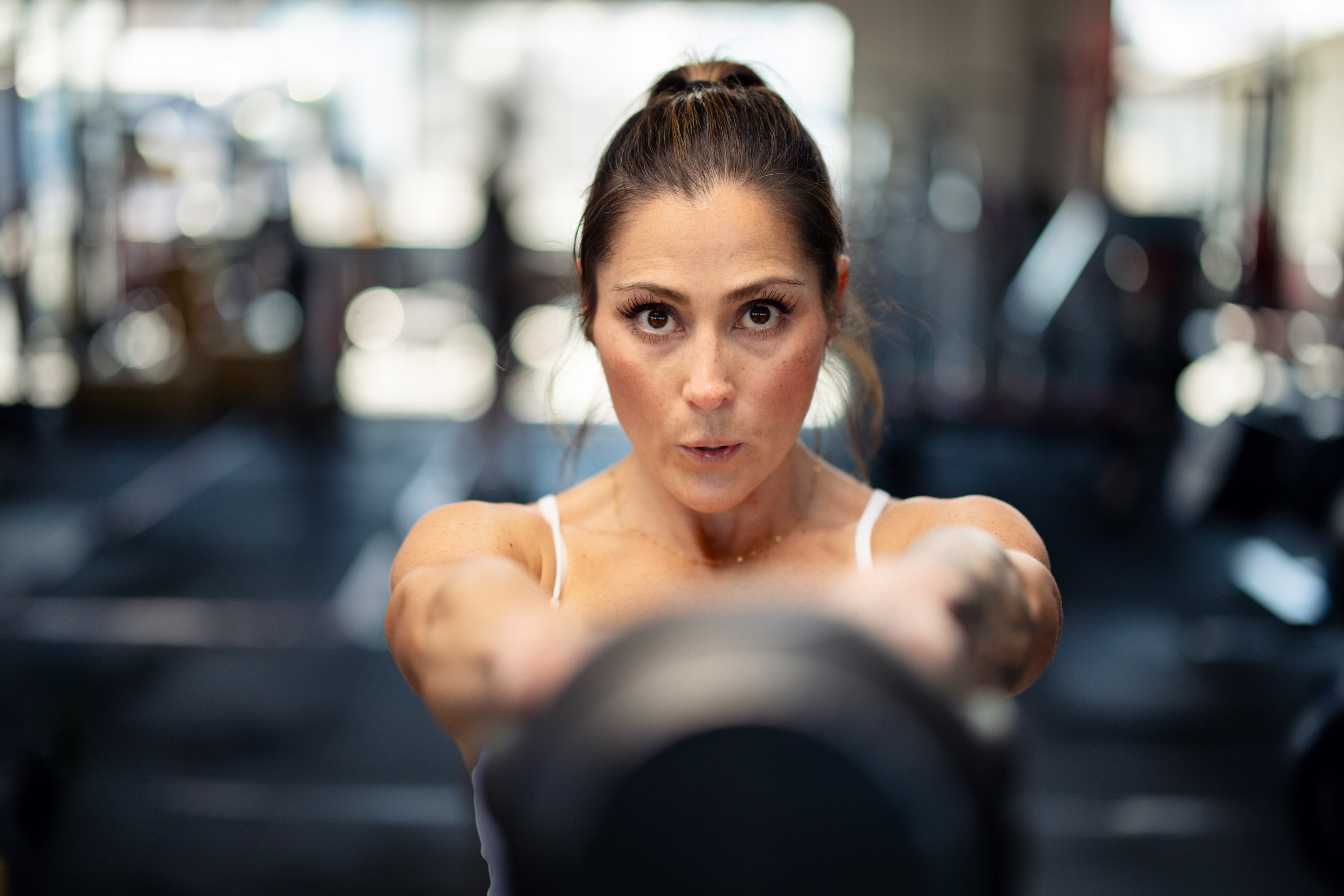Cupping is an age-old remedy that’s been historically used to treat a variety of ailments. Recently, it’s come back into the limelight and if you’re like many people, you’re wondering what all the fuss is about.
What is cupping? Is cupping effective? Is it backed by science? How many cups do you need for cupping?
We answer all those questions and more in this up-close look at cupping.
What is Cupping?
Cupping is a type of alternative non-pharmaceutical therapy used as part of Traditional Chinese Medicine that involves placing cups on the skin to create suction. This suction promotes healing through increasing blood flow and the flow of “qi” in the body. FYI, ‘“qi” means “life force” in Chinese.
Cupping increases blood circulation to the areas of the body where the cups are placed, which is purported to encourage cellular repair and relieve muscle tension. It may also help create/restore connective tissue and encourage blood vessel formation, further improving circulation.
Cupping is most often used as an adjunct therapy for whatever current conditions or ailments they may be facing.
Types of Cupping
When it was originally developed many centuries ago (as far back as 1,550 B.C.!) cupping was performed using animal horns, and over the years, the horns have been replaced by bamboo, and later on, ceramic cups. Today, cupping is performed with rounded glass cups that look like a ball with one of the ends opened up.
The “suction” effect that happens during cupping is a result of the heating process of the cups, which was originally accomplished using fire. As the heated cups cool, the skin is drawn in as the air is removed, creating the “suction” that is so well-known with the practice of cupping.
Modern cupping is performed following either of two methods:
- Dry cupping involves using only suction, whereas
- Wet cupping involves suction as well as controlled medicinal bleeding
Note: the cupping practitioner usually determines which method is appropriate for you given your age, medical condition, preferences, etc.
Cupping Up-Close
So, what happens during a cupping treatment?
Well, regardless of wet or dry cupping, the practitioner will put a flammable substance (alcohol, paper, herbs, etc.) in a cup and set the it on fire. This heats the cup, and once the fire goes out, the cup is placed upside down on your skin. As the air inside the cup cools, a vacuum is created, causing suction and leads to your skin being drawn up and into the cup. Additionally, the skin also reddens due to the increased blood flow.
Note: Certain modern practitioners have transitioned to machine pumps with silicone cups that can be moved from one spot to another on your skin, yielding a “massage-like” sensation.
If it’s your first time being “cupped”, you may only receive 3-5 cups, though it may be as high as seven cups if you’re a cupping veteran. Now, here’s where we get into the differences of dry and wet cupping.
In dry cupping, cups are set in place for usually between 5 and 10 minutes and then removed, whereas with wet cupping, the cups are usually only in place for approximately 3-5 minutes before the practitioner removes the cup and makes a small incision to draw blood. Following the “blood letting”, the practitioner will apply antibiotic ointment and a bandage to prevent any infection.
While that might seem pretty scary having someone cut your skin and release blood, cupping enthusiasts believe it helps purify and detoxify the body from any hazardous toxins, which promotes healing, though this is not substantiated by any scientific evidence. Following your cupping treatment, the skin should begin to look normal in about 7-10 days.
A third, and less common, form of cupping has been tried recently called “needle cupping” where the cupping practitioner first inserts acupuncture needles into the skin and then places cups over them.
Before any cupping treatment, it is best recommended to fast or eat a light meal approximately 2-3 hours before your cupping session.
Common Applications of Cupping
Over the centuries, cupping has been used to treat a wide variety of conditions, including everything from minor aches and pains to skin issues, such as acne. Since the cups can be applied to acupressure points, cupping has been used to also treat digestive issues and other conditions commonly treated with acupressure.
A comprehensive review of cupping conducted in 2012 noted that the practice may offer more than simply placebo, and stated that cupping could help with the several conditions, including<1>:
- Acne
- Coughing
- Facial paralysis
- Dyspnea
- Herpes zoster
- Cervical spondylosis
- Lumbar disc herniation
However, the review clearly states that most of the 135 studies included in the review are highly biased and additional studies are needed to determine whether or not cupping is truly effective for the conditions outlined in the review.
Additionally another report in 2015 in the Journal of Traditional and Complementary Medicine stated that cupping may be beneficial for pain management, herpes zoster, and acne <2>, and even more recently, a 2017 review of the literature<3> concluded:
“Cupping therapy and acupuncture are potentially safe, and they have similar effectiveness in relieving pain. However, further rigorous studies investigating relevant pain-related conditions are warranted to establish comparative effectiveness analysis between these two therapies. Cost-effectiveness studies should be considered in the future studies to establish evidence for decision-making in clinical practice.”
Finally, a 2018 study suggests that a “clear relationship between Hijama and the reduction and control of SBP in patients with hypertension. Therefore, Hijama can be used as an adjunct to conventional therapy, which may allow down titration of given doses of antihypertensive drugs.” <4>
That final study is interesting and somewhat obvious, anything that decreases the total volume of blood in the body is going to lead to a reduction in systemic blood pressure. Is bloodletting a long-term solution to high blood pressure (hypertension)? No.
Potential Side Effects
Provided your seeking treatment from a well-trained and qualified cupping practitioner, the side effects and risks of cupping are relatively minimal. Possible side effects that might occur as a result of your cupping treatment include:
- Mild discomfort
- Burns
- Bruises
- Skin infection
- Scarring (if receiving wet cupping)
Additionally, you may also feel slightly dizzy or lightheaded during your treatment, as well as potential sweating (from the heat) or nausea).
Following your cupping session, the skin on the areas where the cups were placed will be reddened and possibly irritated. If you did wet cupping, you will also likely experience pain where the incisions occurred.
Be aware that infection is always a possibility when undergoing wet cupping. The risk is low, and typically not a concern provided that the practitioner is using proper sanitation methods on the instruments involved as well as your skin.
Some things to look for in your practitioner, especially if they’re performing wet cupping on you. They should wear:
- Disposable gloves
- Goggles (or some form of protective eyewear)
- Apron
Using properly sterilized instruments helps prevent infection and ensures you’re not at risk for contracting certain viruses such as hepatitis and human immunodeficiency virus (HIV).
Tips on Cupping
Before we finish this expose’ on cupping, we’ll leave you with a few parting pointers to be aware of should you be interested in giving this ancient healing art a go.
Most degreed medical professionals (i.e. doctors) are not trained or have any background in adjunct (complementary) therapies typically used in alternative medicine. As such, your doctor will in all likelihood be very skeptical of your attempt to try cupping.
Certain traditional medicine practitioners are such strong believers in their craft, that they may encourage you to forego standard Western medicine practices in favor of their methods, but again, this is not advised. Always consult with your physician before starting or stopping any treatments, no matter how old they may be.
Additionally, if you do attempt cupping, make sure to keep up your regular doctor visits and keep them informed of your desire/progress with cupping.
Finally, cupping isn’t for everyone. If you are pregnant, menstruating, elderly, or a child, cupping is NOT recommended. Also, if you have any form of organ disorder, it is strongly advised that you do not try cupping.
Cupping Wrap Up
Cupping is an ancient healing practice used to treat a wide range of ailments. Anecdotal evidence speaks highly of the practice, and there is some scientific research to support its effectiveness in reducing aches and pains. It is by no means a replacement for regular doctor visits or western medicine, and should you be interested in giving cupping a go, always make sure to check with your primary care physician before attempting it.
References
- Cao H, Li X, Liu J. An Updated Review of the Efficacy of Cupping Therapy. Malaga G, ed. PLoS ONE. 2012;7(2):e31793. doi:10.1371/journal.pone.0031793.
- Mehta P, Dhapte V. Cupping therapy: A prudent remedy for a plethora of medical ailments. Journal of Traditional and Complementary Medicine. 2015;5(3):127-134. doi:10.1016/j.jtcme.2014.11.036.
- Zhang Y-J, Cao H-J, Li X-L, et al. Cupping therapy versus acupuncture for pain-related conditions: a systematic review of randomized controlled trials and trial sequential analysis. Chinese Medicine. 2017;12:21. doi:10.1186/s13020-017-0142-0.
- Al-Tabakha MM, Sameer FT, Saeed MH, Batran RM, Abouhegazy NT, Farajallah AA. Evaluation of Bloodletting Cupping Therapy in the Management of Hypertension. Journal of Pharmacy & Bioallied Sciences. 2018;10(1):1-6. doi:10.4103/jpbs.JPBS_242_17.

